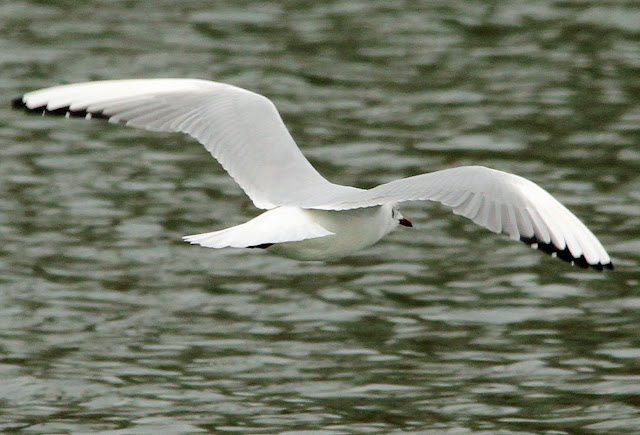This is a first winter Black-headed Gull, Chroicocephalus ridibundus and you can see the typical black lines extending forwards on P10 and P9, and the brown carpal/tertial splodges.
This is the same bird a moment later, this time at the point of landing a second time, showing incredible wing angles as the bird slows down, as well as the obviously orange bill and legs.
Here is a Common Gull,
Larus canus, facing up to an adult Black-headed Gull on the left. Intriguingly on the Black-headed Gull, the P7-P5 black wingtips are showing white tips themselves on the upperwing, said to be a feature of fresh feathers, and thus indicating a survival from last autumn's moult. These are rather parallel to the white tips of the corresponding feathers seen in the Common Gull. Behind the adult Black-headed Gull is what MIGHT be a second winter Black-headed Gull, showing the black lines running along the edges of P6 and P7 - unless this is actually an "angle" thing, and maybe even bit of a snare and a delusion.

The bird below is a first winter, with two completely white newly moulted feathers in the middle of the tail (T1) , breaking the juvenile pattern of the brown-black sub-terminal tail bar extending across most of the width of the tail. The central feathers also seem longer - because they are fresh and not worn? Some birds do include these two central tail feathers in the partial moult to first summer plumage (Olsen and Larsson). All the other tail feathers have to wait until the full moult in summer-autumn! You can also see some white on the underside of P7 and P8, and the clearly orange colour of the bill at least.
As in one of the photos above, this Black-headed Gull shows the small white tips to the primaries still showing from last autumn's main moult, despite the very blurry photo. Quite a few birds are still showing these, but this may change over the rest of the year as these feathers wear away slightly, until we reach next year's moult (in July - October).
Here are the white patches within the dark of the underside of primaries again, but I think it would be useful to look at some specimens in the hand to fully understand these colour shifts and the variation within them. The white tips to the feathers from last autumn's moult can also be seen again!
These two adults below are respectively nearly at the end, and nearly at the start of the head moult, which is proceeding rapidly at the moment. You can quite clearly see how the moult starts at the back of the head, as in the bird of the right, and may be nearly complete across 90% of the head before the last areas at the front start to go dark, as in the bird on the left. The white "eyelids" become increasingly prominent of course as the background of the rest of head goes dark.
Two further stages in the head moult! The moult to the summer breeding plumage is a partial moult, only involving the feathers of the head and body.
This is a better shot than some of the above, with an adult showing the upper wing pattern really quite clearly. Note the "ruffle" of possible back-thrust (about to stall?) along the inner shoulder as the bird breaks abruptly to a halt ready to land.
This first winter shows the upper wing pattern beautifully, with the left hand wing sitting neatly over an adult wing just behind it, giving a great comparative shot! See how the first winter wing has a dark trailing edge almost all the way along it, until the wing nearly reaches the body , brown splodging all along the lesser coverts, and sooty markings on the front edge of the wing particularly at the median coverts and greater primary coverts. The dark lines along the outer primaries are also quite clearly visible.
The bird swimming in front (and the bird to the near left?) is also a first winter from the brown on its lesser coverts, and its orange bill.
Here is another view of the upperside of a first year wing, with rather more brown lines along the coverts perhaps - its all very variable of course! Again notice the orange bill. And yes, it is the head and yellow bill of an adult Common Gull in the front of the photo, trying to get into the act.














































